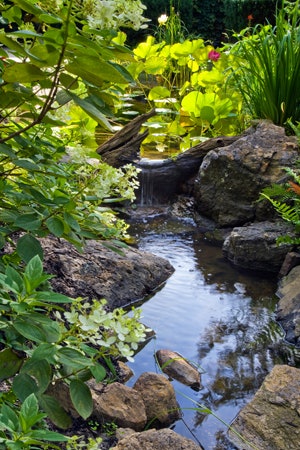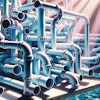
 © Linda Oyama Bryan
© Linda Oyama Bryan
Creating streams and waterfalls that effectively mimic nature and fool the eye requires careful attention to the finest details, says pond and stream specialist Tim Krzeminski, founder of Laughing Waters (Chicago, Ill.). Here he shares key concepts and techniques he uses to generate work that both soothes the soul and inspires the imagination.
Just about every project I do is meant to tell a story as to why the water is there in the first place. It's not the sort of telling expressed in words or illustrations, but instead rendered in the language of nature, where everything is interconnected in infinite webs of cause and effect.
Somewhat ironically, I suppose that's why whenever possible I try to avoid revealing the entire watercourse from a single viewing area. Instead, I create vignettes within the system where the viewer is drawn into the scene and will pay close attention to the details. And it's within those sights, and sounds, where the story of the water is revealed, where the closer you look, the more realistic the scene becomes.
That's quite the tall and infinitely challenging order because in reality it's impossible to completely mimic nature. It takes the closest possible attention to issues such as how the water's flows divide into rivulets or gather into pools, how the forces of erosion have sculpted the rock material, how the edges of the system fuse into the surrounding landscape, how moss and lichen have developed on the stones' surfaces, how the plant material interfaces with the stone and the water, and where the water comes from and where it goes.
All of those elements and countless others must work together to create the impression that you're looking at the work of nature's forces over geological time. It's not easy, but it's also great fun and ultimately when you get it right, or at least come close, the power to transform the space can be something very special.
Almost Natural
It's very difficult to isolate individual elements in this kind of work in terms of what's the most important because everything has to work together in a harmonious and seemingly natural way. As is true of any constructed aquatic space, the design must start with the setting and what the clients hope to achieve. That's why experience has taught me that, for example, the edge treatments are extremely critical — as well as the most time consuming and challenging. Edges are so important because how you treat them establishes what the body of water is to begin with and how it interfaces with the landscape.
Consider a constructed edge used on a formal pond or a swimming pool; it says immediately that part or all of the system is man–made. In pond work, that's not necessarily a bad thing, so long as you're clear in your own mind the story you're trying to tell. Perhaps you're working with the idea that a natural body of water was at some point in time altered by a landscaper, or perhaps a man–made fountain has existed for centuries and is slowly being reclaimed by nature. Those scenarios start on the edges.
Still, that's only the start. The greater challenge is making the garden look as though nature has been left to work its magic unfettered by human hands. That requires using earth, stone and plants that are consistent in form and placement with the surrounding landscape.
Rocks don't tend to just appear out of nowhere along the edge of a stream or beneath a waterfall, and they certainly don't line up in a row like a string of pearls. Instead you have to create the illusion that stones are distributed naturally, exposed and then influenced by the water and that plantings came along and established themselves to draw their life from the water and in doing so, also affect the shape of the stone and the flow of the water.
That sense of natural interconnection is why it's so important to always keep in mind that although essential to the scene, the water is only part of a natural system that exists in biological and geological balance. These things can be tough to keep in mind amid backbreaking labor on site, yet it's exactly those big ideas that must drive the painstaking work.
With all of that in mind, examine these images from projects I've done with an eye toward the details that hopefully tell a natural story.
|
Elegant FallsThis is a prime example of not showing the entire feature from a single viewing position. Here we see a complex waterfall nestled among lush plantings. The idea is the viewer is rewarded by peering deeply into the landscape; hopefully inspiring them to venture further into the setting. It's very important that you don't see where the water is originating, but instead catch just a glimpse of something almost mysterious in the garden. The main idea with a scene like this is to generate interaction with the setting. I often incorporate steppingstones and pathways that lead into the garden where you come upon different views of the water and places where you can touch it and close your eyes and take in the sounds of the moving water and perhaps the fragrances of the plantings. |
|
Closer to FineHere's the payoff for traveling into the garden and coming close to the water. This type of intimate view reveals the use of surface stones with their lichen and surfaces impacted by exposure to the elements. It offers a close-up look at the intricacy of the falls themselves, how the water divides and appears to almost force its way through the rock structures. This waterfall shows off a great deal of detailing I picked up in Kauai, where I took long treks deep into the tropical forest and spent hours and hours closely examining the way that water influences the landscape. Although this is not a tropical garden per se, the principles of erosion and evidence of the passage of geological time are the same. |
|
On the SteepThis was an extremely challenging project that involved a dramatic slope in the back of the property. Here the massive boulders conceal a retaining wall, creating a bold backdrop for the patio area. The narrative was that this dramatic set of falls begins at some unseen point behind a tree line of pines at the top of the system. In this case, the water's source is a bog that doubles as a bio-filtration area. It's loaded with aquatic plantings that add beauty while also masking the water's source and providing places for beneficial bacteria colonies to form. This natural system of chemical exchange helps keep the water clear and inviting. Another key point in this project was the use and placement of stone material that appears to reveal natural striations and grain patterns that have formed over millennia and are now being sculpted by the water flow, plants and the elements. |
|
Slow GrowthIn this image, we see another example of dividing the flow of a waterfall to generate the appearance that the water has coerced its way through the stone structures over the ages. In this case it was a relatively simple matter of placing a stone at the top of the falls to divide the flow. The effect is convincing, however, because of the way the stones are cleaved to mimic a natural erosion pattern. In nature, rarely do you see water flowing over a straight edge. Instead over time the water will carve a niche back into the stone or the slope. Another key factor on display here is the importance of moss, which works beautifully to soften the appearance of the stone and gently fuse the presence of stone with the plant material – as if to say the dance between stone and flora reaches far back in time. The nice thing about moss and lichen is that they have the ability to essentially reactivate when exposed to water. I often accelerate that process on site with my own concoction of malt beer, buttermilk and moss, which I mix in a blender and then paint on the stones. This particular image was taken shortly after installation, as time goes by the moss will continue to spread and completely cover much of the stone's surface. |
|
Brusque CharacterThis is a prime example of the water expressing a narrative and what I call "designing time" into the work. There are instances where revealing water's delicate and almost lyrical quality is the desired effect. In other situations, however, you may choose to reveal water's intrusive and forceful character. That's what's happening here. The water appears to have aggressively forced its way through the rock structure. The single river rock placed on the weir shows how water moves material down stream and it imposes its will on the landscape. There's also a cautionary tale to consider. One of the common mistakes I see in this kind of work is the use of too much water flowing through a system, creating an unnatural out of scale effect. I'm a fan of using large stone structures and relatively modest flows to create a more natural effect. By contrast, in this case we wanted to generate the visceral excitement that comes from a flow that has gathered and is cutting its way down the slope. |
|
Variable SpeedA common mistake seen in many systems is placement of a large waterfall at the very top of the system. In this project we're using the placement of a weir stone that acts as an overflow from a koi pond just behind the falls. This is also an example of how you create interest by governing the rate of the water's flow. The sheeting water over the weir stone is relatively vigorous, but then changes character as it slows in the channel and pool below, creating slower, reflective water that embraces large boulders (on the left) that appear to have tumbled down from a higher elevation. As is true with all of these settings, and especially so in this image, the presence of mature plantings that cuddle and cascade over the rock, obscuring views and then alternatively revealing them, is all-important. The reason being, the plants are an important part of the natural story that you're telling. It might look random, but part of the design and planning is being sure that you leave pockets for plants with ample space for soil and root systems. |
|
Still WaterWhile moving water can generate tremendous interest and suggest ancient struggles between the water and stone, there's tremendous potential found in using very quiet water as well. In this image, we see both how the smooth surface of the water creates reflections of the surrounding stone and plant material, while it also enables you to view into the water and see the "landscape" below the surface. Another common mistake seen in pond craft is the use of overly uniform materials beneath the surface, which often looks manmade. By using boulders and smaller pieces in conjunction with aquatic plantings, and of course fish, you create a scene that rewards those who step up the water's edge. |
Comments or thoughts on this article? Please e–mail [email protected].














































